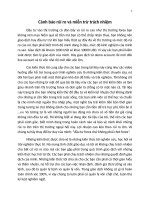Follow price action trends laurentiu damir
Bạn đang xem bản rút gọn của tài liệu. Xem và tải ngay bản đầy đủ của tài liệu tại đây (2.37 MB, 53 trang )
Follow Price Action Trends
By Laurentiu Damir
Copyright © 2012 Laurentiu Damir
All rights reserved. No part of this book may be reproduced or transmitted in any form
or by any means, electronic or mechanical, including photocopying, recording, or any
information storage and retrieval system, without prior written permission of the Author.
Your support of author’s rights is appreciated.
Table of contents
Introduction
Trend
Corrections
Confirmation
The Degree
Trend change
Trade setup
Trading system step by step
Trade examples
Introduction
This is a forex system based solely on reading the price action. It is a trend following
system that focuses on points in the market where the trend is about to change its
direction, enters the market trying to ride the newly formed trend all the way to its finish
line. By doing this in the correct way, this system has the potential to deliver thousands
of pips in the long run because shortly after a trend ends, usually another one emerges
preceded by a small period of consolidation. It sounds simple, but the key component of
this price action system is to correctly identify the current trend, know when a change in
direction of the trend is about to take place and then manage the new developing trend in
a way that allows you to ride it until it ends. All of this is done by carefully reading the
price action without the use of any technical indicators, magical formulas and other
nonsense like that.
This is not a very easy thing to do as you must pay great attention to every single detail
of the price action, but once you get the hang of it trading this way will make you very
profitable in the long run. This book explains with very great detail all of the above and
gives you the complete trading system with clear entry, stop loss and exit rules, rules
that if respected to the letter, can bring you hundreds of pips for every trade you make.
Let us move on now to the core part of this forex system which is the trend.
Trend
You’ve probably heard a million times by now the saying “the trend is your friend”.
Well, you’ve heard it because it is true, if you want to be profitable in trading you must
always know what the trend is because the trend signifies strong conviction from the
vast majority of market participants that the fair price, fair value of a specific currency
pair should be above or below the current level at that time so they all join forces and
push the price up or down creating a trend this way. But let us see what a trend actually
is from a technical point of view. A trend is a series of impulsive strong moves in one
direction, each of them followed by small corrections or retracements. Let’s visualize a
textbook trend:
We have in the above pictures an ideal uptrend and a downtrend. As you can see they
consist of strong directional moves followed by smaller moves in the opposite direction
which are in fact formed by traders taking some profit from their positions. This
alternation of impulsive moves with correctional ones gives birth to what are known as
the highs and lows of a trend.
For an uptrend the high is formed when the correctional move starts and the low is
where the same move ends and price resumes the trend. For a downtrend things work
the other way around meaning that a low is formed at the beginning of a correction and a
high takes form at the end of the same correction and price resumes the downtrend.
In the examples above you can see that these highs and lows can easily be connected
with a trend line. So, to conclude this, we have an uptrend when the price starts to make
higher highs (HH) and higher lows (HL) and we have a downtrend when price is
making lower highs (LH) and lower lows (LL) just like in the pictures above.
Unfortunately, trends so simple and clear like those above are very rare in real market
conditions. Let’s see some real trends:
We have above one uptrend and one downtrend. This is just about the closest that real
market trends can get to resemble those ideal textbook trends. It doesn’t get any easier
than this in real market conditions. However, trends like these two above are rare
especially in the forex market which is known to be a very volatile market. Even in
these clear trends you can see that there are some variations, there are some smaller
trends contained in the bigger trend. Let’s see now how a more common trend for the
forex market can look like:
This is a downtrend but you can tell it is more complicated than the previous ones just
by looking at it. There are some important rules I designed to help you correctly identify
and mark the components of a trend. Here is the first one.
Corrections
Corrections or retracements can also exist in the form of a trading range that has an
upper and a lower boundary where price stalls for a period of time and takes a breath
before resuming the trend.
As you learned before, a correction move happens when traders start to take some profit
out from the market and, as a consequence of that, price goes for a short period of time
in the opposite direction only to resume the trend later on. In this particular example we
have a downtrend and the people that are short are starting to take profits. When these
sellers start to do this, the people that are convinced that this pair will go upwards from
here decide that this is a good level for them to buy this pair. So, in general, a correction
move begins because some traders decide to mark some profits and at the same time
other traders enter the market in the opposite direction. In the case above, there weren’t
many people buying this pair at the level where the correction started to unfold and so
price did not make a classic correction. When a correction looks like a consolidation
range it means that the current trend in very strong and it is very likely that it will
continue further.
In the above example you can see that in the same trend further down we have a
different form of correction that basically has its own highs and lows. It has a first
impulsive move opposite to the trend direction and at that point you could very well say
that this is a classic correction but, as you can see it makes a small correction and then
another impulsive move upwards. Because this correction has its own highs and lows
you could make the mistake to consider it as a trend change. However, it stays very well
confined into the territory of the last impulsive move down of our trend. It stays well
below the last lower high of our trend so it is still a correction even if it develops a
higher high. But you will learn more about this we get to the change of trend section.
Corrections can take a lot of forms, these are just the most common ones, the important
thing to remember is that for a correction move to be valid it must not be bigger than its
impulsive move, it must not surpass the beginning of the impulsive move. Let’s see some
examples:
You can see on this chart that the correction move has to always be smaller than the last
impulsive move. At the bottom of the chart you see an impulsive move but it is followed
by a larger move in the opposite direction so that cannot be considered a correction.
This is how a trend usually changes direction but we will learn more about this later on.
Okay, I think it is pretty clear what a correction is by now it is not hard at all to see it.
Now let us go to the second important rule of a trend and that has to do with correctly
identifying highs and lows.
Confirmation
The rule is that any high or low must be confirmed by the subsequent price action. We
know from the above pages that highs and lows are formed at the beginning and finish of
a correction move but, for those highs and lows to be valid price has to make another
strong impulsive move in the direction of the trend. By strong impulsive move I mean
price has to go well beyond the beginning of the correctional move that made these
potential highs and lows. Only after this strong impulsive move happens we can label
those potential highs and lows as new valid, confirmed highs and lows in our trend. If
this impulsive move does not happen or it is not strong then our potential highs and lows
are not confirmed, they are not valid. Valid highs and lows remain the previous ones that
have been confirmed by subsequent price action. Let’s see a chart so you can better
understand this:
You can see in this chart above that what we have to do to correctly identify the highs
and lows of our trend. As the trend unfolds in real time we mark every level where
there has been a change in direction as a potential highs or low and then we wait for the
next impulsive move down, in this case, to tell us if our potential high/low has been
confirmed and it is valid. If the next move down doesn’t go well past the start of the
correction then we disregard these levels that we marked as potential high/low and we
wait for price action to make its next move and show us where the new and confirmed
high and low will be.
Let us see another example:
Here we have an uptrend , price makes two HH and two HL and then when it looks like
it is preparing to make the third pair of HH-HL the pair starts a series of quick up and
down moves almost equal in length. None of these can be considered as a new HH-HL
because price doesn’t go up at all, it just stays there and consolidates and so we do not
have a new pair of HH-HL here. After this you can see that price does go up with a
pretty strong move past the point where correction began but doesn’t go far and retraces
back down. We still don’t have a confirmed pair of new HH-HL. In the end, finally
price goes very strongly upwards with a massive impulsive move, thus confirming our
trend’s new HL and HH. Things like this are pretty tricky to manage in real time but
with the help of this book and with practice it will become easy in time. Let’s see some
other examples:
In the chart above we have the same situation as in the previous chart. Okay, now let’s
see a more complicated one:
In the downtrend above you can see that we have a strange trend that has the first and the
last two pairs of LH-LL very close to each other. You saw in the earlier examples that
we disregard our potential highs and lows if the next impulsive move does not go past
the starting point of the correction move or it goes past just slightly. In situations like in
the chart above where things are somewhere in a gray area, meaning that the impulsive
move goes past a little bit more than slightly but still not enough to confirm the pair of
LH-LL, we do not disregard this pair of LH-LL, we take note of it and after the price
makes another pair of potential LH-LL and it is finally confirmed by a strong impulsive
move, we label the first pair as well as LH-LL. So we have two pairs of LH-LL close to
each other in situations like these two in the chart above. Let me explain better so you
can understand when to disregard a pair and when not to. From my experience I have
come to the conclusion that the impulsive move that comes after a correction to continue
the trend has to have the length, size of approximately two times that of the correction
move for me to consider it as a strong impulsive move that confirms and validates any
potential high or low. Remember: strong impulsive move is a move with the length of
approximately 2 times that of the correction or more. Moderate impulsive moves are
those two in the last example where we had to lable 2 pairs of LH-LL close to each
other. Let’s go to that chart again and see what was the size of these moves with respect
to their preceding corrections:
This is the the same chart with the same trend but it is zoomed in so you can better see
what is going on with those first 2 pairs of LH-LL we talked about. You can see the
correction move has a span of approximately 260 pips and moderate move down as I
call it is 380 pips in length. This means it surpasses the start of the correction by almost
have of the correction move length. If the amplitude of the move down would have been
500 pips or so then this would’ve been a strong correction move and we would have
labeled the first pair of LH-LL right after the move, we wouldn’t have to wait for that
huge move down after the second pair. Let’s see on the same trend the last two pairs of
LH-LL which have identical dynamics as these first two:
Here the impulsive move is not that big compared to the correction move like in the
previous example but it is still 30% bigger in length so this is also a moderate
impulsive move.
Here is another moderate impulsive move.
And another one:
And yet another. You can see here that the sebsequent strong move down never came so
our potential pair of LL-LH was never confirmed.
This is a strong impulsive move down, it is almost two times bigger than the correction
in length.
This is a very small impulsive move that passes the start of the correction by only a few
pips. We definitely do not have a pair of LH-LL here.
We don’t have a pair here either. We disconsider those potential LH and LL. You can
see this was a very goog thing to do as price later rose back up and passed our potential
LH by a few pips. We will see later when we get to the stop loss placement why this is
important. The exact same thing happened in the previous example.









